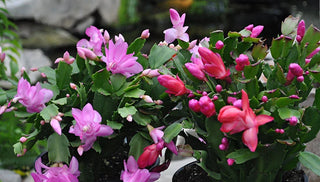My grandfather let me water his Christmas cactus carefully when I was a toddler and he proudly showed me how to count each flower bud. When the fat red buds opened, they looked like arching Roman candle fireworks or dragons spitting yellow flames. That cactus is my first plant memory and the spark that lit my own lifelong love affair with horticulture.
My grandfather, born in Vermont in 1892, was an ardent gardener. He grew vegetables and fruit for the family table, manicured a perfect postage-stamp lawn, and dearly loved his peonies and roses. To get through the long winters, he kept a few prized flowering houseplants in the window near his reading chair. I inherited his Thanksgiving cactus when I was 18. It has led a less-pampered life since then, but it still blooms reliably each autumn.
 Buds form when nights grow longer. Photo: Ann Whitman
Buds form when nights grow longer. Photo: Ann Whitman
Some Christmas cactus (Schlumbergera) hybrids have pointy teeth on their stem segments and others have scalloped segments, depending on their parentage. Plant breeders have produced a wide range of flower colors — from deep red and hot pink to orange, yellow, and white.
How to Encourage Buds and Blooms
All hybrids naturally develop flower buds in early autumn, when the nights get long and the temperature drops to 50 to 55 degrees F. If your plants don't set buds on their own, put them in a cool room where they will receive at least 12 hours of uninterrupted darkness each day for six to eight weeks. After the buds form, they no longer need the long-night treatment. Keep the soil slightly moist and allow it to dry between waterings.
These plants are native to tropical areas with high humidity and may drop their buds and flowers if the air is too dry or the plants are exposed to sudden cold. My grandfather put his flower pots in saucers, then set them on trays of pebbles and water to keep the humidity high in the winter. To prolong the bloom, keep the plants as cool as possible. Temperatures in the mid-50s to mid-60s are best.
Tough and long-lived, Christmas cactus can be passed easily from one generation to the next, blooming for family gatherings and cheering the darkening autumn days. I've given many cuttings of Grampa's cactus to family and friends over the years. Someday, one of my kids or grandkids may inherit the original.
Care at a Glance
- Light: Medium to bright, with some direct sun, such as an east-facing window.
- Water: Keep soil evenly moist when plant is in bloom. Once flowers have faded, allow soil to dry somewhat between waterings.
- Fertilizer: Feed every other time you water when plant is in bud or bloom. After that, fertilize monthly.
- Repot annually: Move plant to a slightly larger pot with fresh potting mix.





